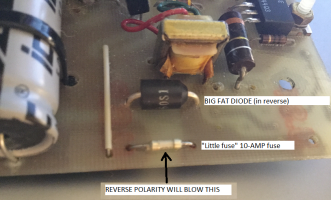Hi:
Quoting from page 45 in
a Whelen manual:
"WARNING: Strobe light power supplies are meant to be used, not to
remain in an inactive state. Use them at all times, this will improve their
proper functioning. Any strobe light power supply that has been out of
service for a long period of time is subject to failure because the elec-
trolytic condenser loses the polarity formation. A strobe light power
supply not having been used for one year or longer is vulnerable to
failure, applies to 1993 & older units.
If this is the case, it is recommended to start operating the system on
a voltage that is reduced by 25 percent for 10 to 15 minutes before
putting the power supply into normal service. This will prevent over-
heating of the condenser while they reform. If the power supply, after
a long period of non use, is operated at full voltage immediately, there
is an excellent possibility that the condenser will become overheated."
I've encountered a few really old power supplies and have had some success reforming the caps. I've also had one or two where the caps were too far gone.
Here's what I've done: I run the power supply on the bench with a multi-meter measuring voltage on across the caps. I apply power for about 15 seconds and see how much voltage it measures and it my case, no more than about 125 at the start of the process (then it quickly drops down). I wait a few seconds and repeat this process and observe that gradually, the voltage will peak higher and higher. At some point, it will get to 270 or so and finally be enough to flash.
You can google "capacitor reforming" and probably find other methods but the above worked for me at least a couple of times.
What you really want to avoid is heat. If the caps become hot, back off. If you can't get the peak voltage to gradually increase, they may be too far gone (which means their likely leaking internally and generating too much heat as a result).
Hope this helps and good luck! Those old 5200s are really cool and very much worth saving!



